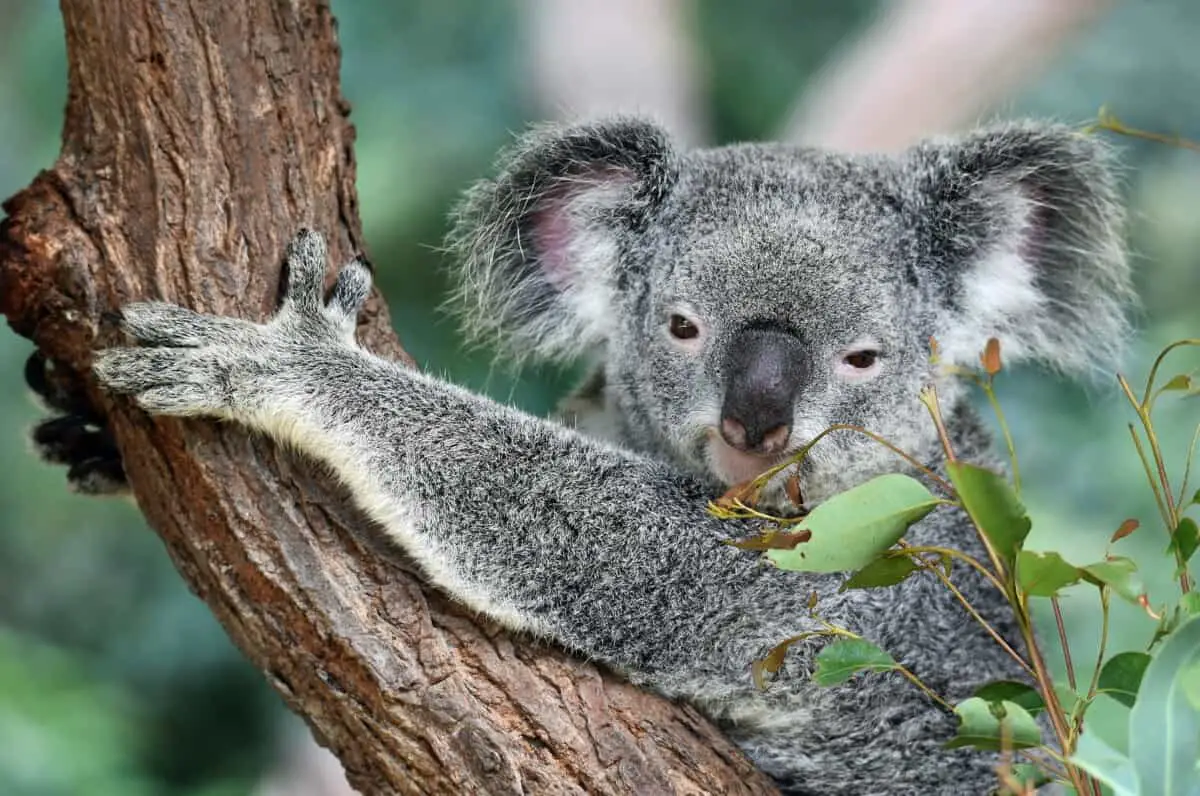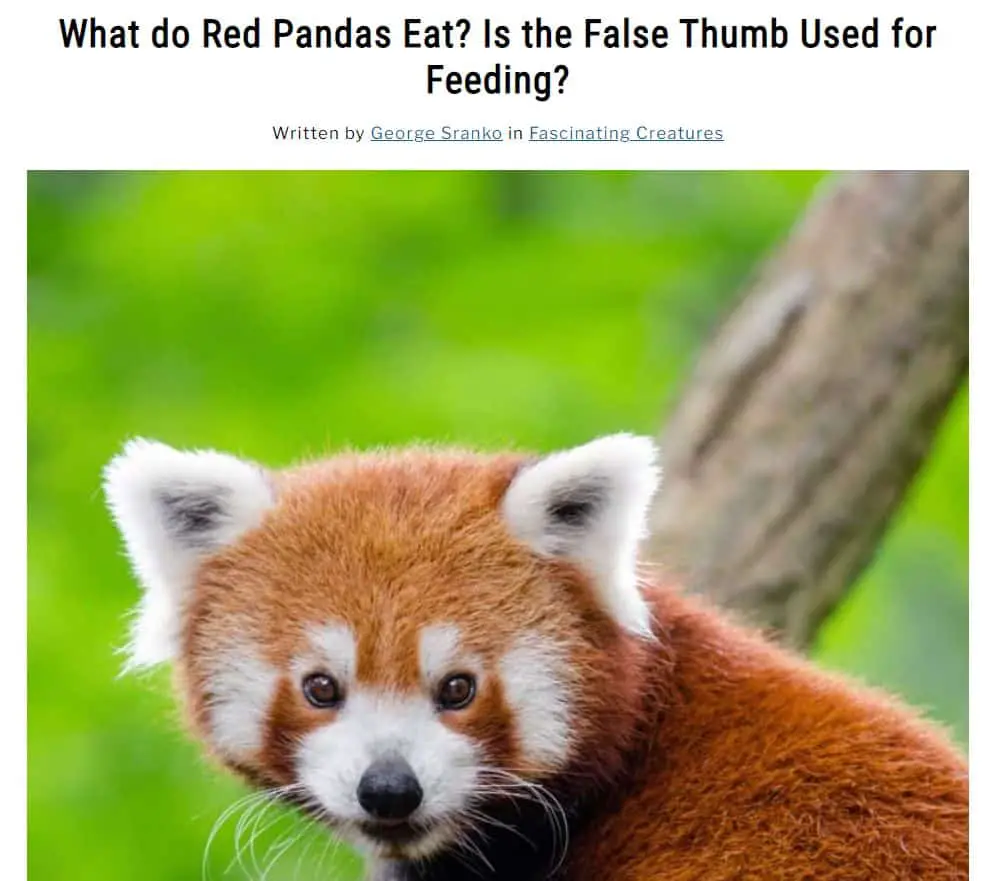Whenever we travel to Australia, we love to observe that iconic marsupial, the koala (Phascolarctos cinereus). Even though it is becoming more and more difficult to see wild koalas in their native habitat, we have managed to track them down by following the amazing roars of the male.
The koala has one of the lowest ratios of brain to body mass of any mammal. Even though koalas are dumb, they have survived because their brains use minimal energy. Using the least amount of energy possible appears to be a key adaptation to surviving on a nutritionally poor, low energy diet of toxic eucalyptus leaves.
What Makes the Koala’s Brain Unique?
Research on the Koala’s brain is ongoing. Scientists often use the ratio of brain volume to body mass or total brain volume to endocranial volume when they present encephalization data. But how accurate are these numbers?
“Given the inconsistency of encephalization indices and animal lifestyles and behaviour, one can wonder what we can learn from encephalization quotients.” (de Miguel and Henneberg, 1998)
It was thought that the koala’s brain only filled 60% of the brain cavity. More recent studies show that the Koala’s brain probably fills about 70-75% of the brain cavity.
Here’s a direct quote from Taylor et al. 2006. (Eutherians refers to all the mammals that have a placenta; that is, all mammals except monotremes and marsupials.)
“The ratio of total brain volume – including olfactory bulb – to the endocranial volume is remarkably larger than previously reported (Haight and Nelson 1987) and closer though still larger than what De Miguel and Henneberg (1998) found. It may be a result of studying a live animal and a fresh dead one, rather than chemically preserved brains. Data presented here fit better into known encephalization data for other marsupials and eutherians (Tobias 1971; Martin 1990). Nevertheless, there is no doubt that marsupials show low encephalization in comparison with eutherians (Martin 1990; De Miguel and Henneberg 1998).”
Taylor et al. 2006
Many researchers believe that the ancestors of the modern-day koala once had a full-sized brain that filled the cranium.
Tim Flannery, one of Australia’s leading scientists, is not too flattering about a koala’s brain! He writes, “Its hemispheres sit like a pair of shriveled walnut halves on top of the brain stem, in contact neither with each other nor the bones of the skull.”
Koalas might be cute, but what’s inside the skull doesn’t sound very impressive.

Photo by David Clode on Unsplash.
Let’s be honest; koalas are not too bright. They expend as little energy as possible, spending roughly 18-20 hours per day sleeping. They move slowly and deliberately from sleeping spot to food source and back again. Sadly, they don’t seem able to adapt very well to moving cars or the dangers of crossing highways. Mortality rates are high close to populated areas.
Thankfully, they can learn to take advantage of underpasses designed to facilitate wildlife travel (see details at the end of this article).
Another major threat to koalas is the escalation in bush fires throughout Australia because of human-caused global warming.
How Did the Koala Evolve To Have a Shrunken Brain?
What does a shrunken brain have to do with poor soil? Australia’s poor soils are where the story of the Koala’s reduced brainpower begins.
Over the past 50,000 years Australia has steadily become drier due to natural climate change and human modification of the environment through burning and hunting. These trends offer a partial explanation for the low levels of nutrients present in Australian soils.
But there’s much more – let’s talk ice (or lack of ice!)
In much of the world, the continents were covered in ice sheets during the last ice age, which scraped away the soil as they moved over the continents. As the newly exposed rocks weathered, nutrient rich soils were deposited on top of the bedrock. This helps explain the rich soils of the North American plains, for example.
In Australia, most of the land mass was never glaciated. Ice sheets never advanced over the continent, so the soils are very old, having undergone weathering and erosion over many thousands of years.
According to the Australian Academy of Science, “this weathering has dissolved vast quantities of nutrients, and washed them away into the groundwater and/or rivers, leaving the soils depleted in nutrients such as phosphorous, calcium and potassium.”
Only sufficiently specialized plants can survive in such nutrient deficient soils. One such set of adaptations is referred to as scleromorphy; characterised by hard and relatively small, thick leaves.
Good examples include the eucalypts, banksias, and heath plants endemic to Australia. Lignin in the leaves makes them stiff, hard, and less susceptible to wilting.

In Australia, Aboriginals have used fire for many thousands of years which has led to additional nutrient losses in the soils associated with frequent fires. Sclerophyllous plants are better adapted to surviving traditional Aboriginal burning regimens than non-sclerophyllous species.
These plants are also well-adapted to living in dry conditions.
Most of the wooded parts of present-day Australia have become sclerophyll dominated because of nutrient-poor soils combined with the use of fire by Aboriginals over thousands of years.
In addition to having poor nutritional value, most sclerophyllous species have toxic and indigestible compounds that help protect the leaves. Gum trees, for example, produce strong volatile eucalypt oils in their leaves that make them unpalatable to most animals. Except for the koala, of course!
Why do Koalas Eat Eucalyptus Leaves?
As frequent fires changed the vegetation in Australia, sclerophyllous species began to dominate the bush. Faced with the changing vegetation, koalas had no choice but to eat the nasty leaves of eucalypt trees to survive.
Those koalas that could survive on a diet that included toxic eucalypt leaves with little nutritional value had an advantage over the others and passed on their genes while the others died off.
Generation after generation, koalas faced selection pressure and only those that could manage on such a poor dietary source would pass on their genes, ensuring the survival of the species even in the face of unrelenting change.
We must remember that natural selection favors those creatures that are best-adapted to the environment they find themselves in.
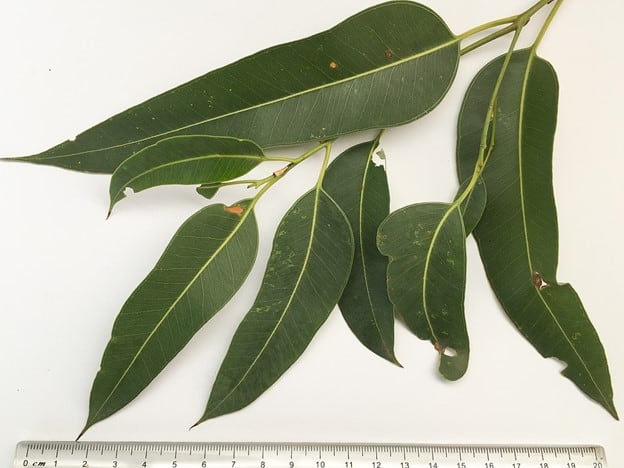
Not only are eucalypt leaves toxic to most animals, they also offer very poor nutritional value. Koalas are extremely selective and will focus on eucalypt species that have the best combination of lower amounts of dangerous chemicals and higher nutritional values.
One of the koala’s key adaptations is to use as little energy as possible whenever moving and feeding.
Chewing leaves takes a lot of work and koalas need to eat for 4-5 hours a day to pack away enough low-calorie gum leaves. Digesting their leafy meal can take over four days. The koala has a large caecum filled with bacteria, which allows it to digest its toxic meal.
What is the Evolutionary Advantage of a Shrunken Brain?
The Koala’s extraordinary brain is a big energy saver.
The brain is one of the greatest energy drains of all the organs. For the average adult human, the brain consumes about 20 percent of the body’s energy even though it represents only 2 percent of body mass. Processing and transmitting all the electrical signals in the brain demands a huge expenditure of the body’s energy reserves.
Given the koala’s problem of living on such a nutritionally deficient diet of toxic leaves, one of the biggest energy savings available was in the brain department. Once again, those koalas that managed to survive by expending minimal energy would be the ones that got to pass on their genes. This provided the koalas with smaller, more energy efficient brains with an evolutionary advantage. Thus, the koalas of today sporting their shrunken brains.
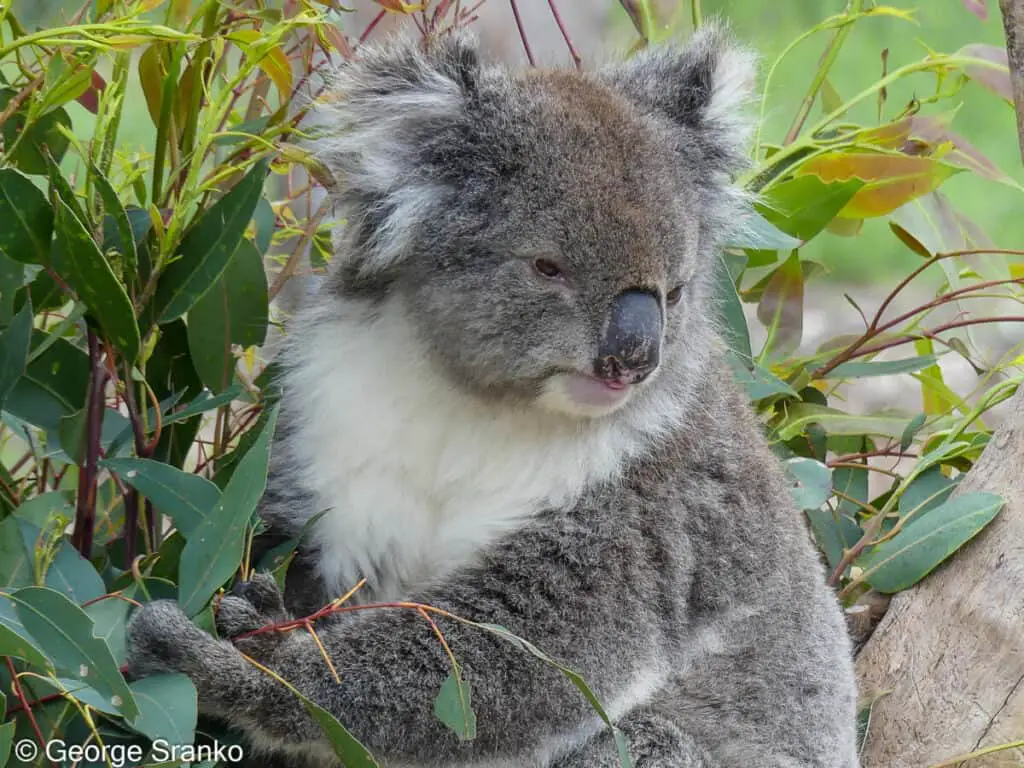
Photo by G. Sranko
It almost seems that evolution must be working “backwards” in the case of the koala. But, of course, this is not true. Evolution works by selecting for features – such as smaller, energy efficient brains – that are better adapted to the environment.
Contrary to what we humans might believe, evolution is not like a staircase automatically leading in the direction of bigger brains. Some of the most successful animals on our planet don’t even have brains!
Interested in Brains… check this out!
If you’re interested in Brains, you will definitely be interested in reading my article about octopuses – creatures that have 9 Brains!! Even when detached an octopus arm will continue trying to pass food to the mouth! Read on!
How can Koalas Compete?
Marsupials in general don’t have much in the way of brainpower or high intelligence. It is interesting that in spite of their lack of smarts, marsupials managed to out-compete early placental mammals.
Tim Flannery suggests “that it may indeed pay to be dumb in Australia.” Since the top predators in Australia are reptiles, Flannery suggests that it may not require great intelligence to outwit them.
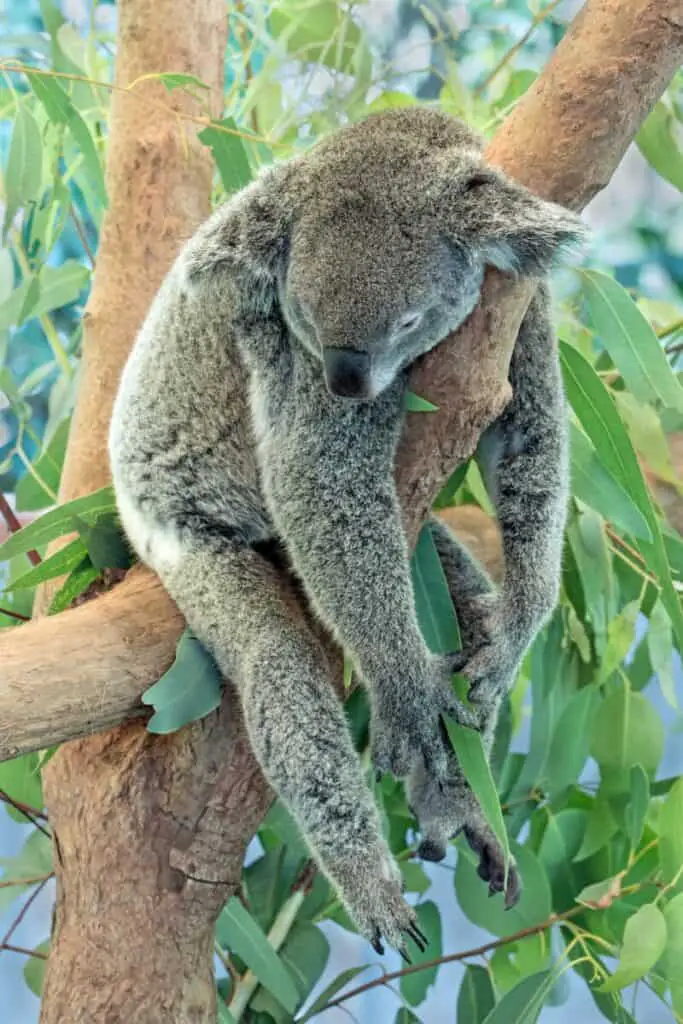
Koalas prove that you can save a lot of energy with “low wattage” brains.
What are the Implications of a Small, Smooth Brain?
Koalas have one of the smallest brain-to-body ratios of any mammal. Additionally, their brains are almost smooth, and not folded like most mammals.
Let’s consider the neocortex. This is the part of the brain that is linked with higher cognition and behavioral complexity. The neocortex is commonly implicated in learning, decision making, discrimination, and memory.
Research is showing that neocortex volume and neocortex to brain ratio might be more instructive than direct or relative measures of overall brain size.
Where does the koala stand in this regard? At the very bottom I’m afraid, with only 28% of its brain devoted to neocortex. Further proof that the koala is likely the dumbest mammal on the planet!
Another interesting aspect of the Koala’s brain is the lack of folding. When we picture a human brain, it looks all folded and wrinkly. The koala’s brain is almost smooth.
Brain folds increase the surface area for neurons. The smooth brain of a koala means that they probably lack higher level cognition and understanding that many other animals have.
And Yet… Koala Intelligence May Be Underestimated
The state of Queensland Australia has spent millions of dollars on a retrofit project to help stop roadway deaths of vulnerable animals, including koalas. Studies have shown that the koalas have quickly learned to use wildlife passageways to cross busy roads as they move between habitats.
Many people were skeptical at first, thinking that koalas would be too dumb to learn how to use the passageways.
Watch this video with Griffith University’s Professor Darryl Jones, a behavioral ecologist, explaining the designs for innovative wildlife overpasses and customized culverts.
Koalas were “able to learn new tricks” when provided with a safe way to cross busy highways.
“This proves they really can innovate,” says Prof Jones. “No koala has ever walked under a road on a ledge ever before in its evolutionary history, and indeed they were doing it within a couple of months.”
“They were able to learn new tricks far faster than anyone would have thought.”
Even though the koala has a shrunken brain, perhaps its intelligence is too often underestimated.
One thing we know for certain: the koala has had the smarts to survive in harsh conditions over thousands of years.
Being dumb turns out to be one of its winning adaptations.
Want to Know More about Koalas?
They Might be Dumb, But At Least They’re Cute!
Here’s a short introduction to these fascinating creatures by Australia Zoo.
Physical description of the Koala
The koala is a medium-sized marsupial inhabiting the eucalypt forests on the east side of Australia. Koalas grow to a length of 2-2.8 ft (60-85 cm). The male weighs up to 30 lbs (13.5 kg), and the female up to 17 lbs (7.9kg).
Koala Facts
- The koala is well-adapted to living in trees and has very sharp curved claws for climbing.
- Koalas have five digits on each front paw, two of which are opposable like our thumbs. Two thumbs on each front paw!
- During mating season, male koalas roar like a miniature lion!
- One of the strangest things about the koala is that it has human-like fingerprints.
- Interestingly, the koala is the only native Australian mammal with a forward-looking face rather than a muzzle.
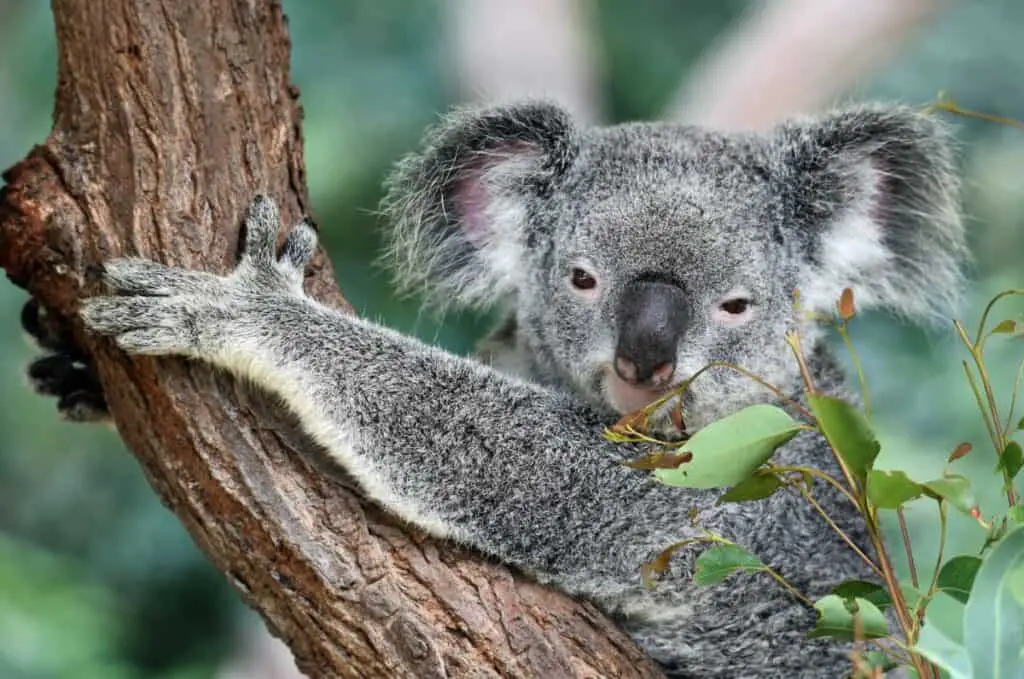
Interested in the cutest animal on the planet? Read my article on the Red Panda, another fascinating creature that has adapted to a nutritionally poor diet. What is the Panda’s false thumb anyway? (What!? They aren’t related to the Giant Panda!)
References
Australian Academy of Science, The Dirt on Our Soils. https://www.science.org.au/curious/earth-environment/dirt-our-soils
de Miguel, C., Henneberg, M. 1998. Encephalization of the Koala, Phascolarctos Cinereus. Australian Mammalogy, 1998; 20:315-320
Dexter C. E., Appleby R. G., Edgar J. P., Scott J., Jones D. N. (2016) Using complementary remote detection methods for retrofitted eco-passages: a case study for monitoring individual koalas in south-east Queensland. Wildlife Research 43, 369-379. https://doi.org/10.1071/WR15153
Flannery, Tim, 2002. The Future Eaters: An Ecological History of the Australasian Lands and People
Jyothilakshmi, T.K., Yamila Gurovich, Ken W.S. Ashwell, 2020. Numerical Analysis of the Cerebral Cortex in Diprotodontids (Marsupialia; Australidelphia) and Comparison with Eutherian Brains, Zoology, Volume 143, 2020, 125845, ISSN 0944-2006, https://doi.org/10.1016/j.zool.2020.125845.
Taylor J. , Brown G. , De Miguel C. , Henneberg M. Rühli F. J. (2006) MR imaging of brain morphology, vascularisation and encephalization in the koala.. Australian Mammalogy 28, 243-247. https://doi.org/10.1071/AM06034
Walton, DW, GR Dyne, 1987. Fauna of Australia
The Gear We Love to Travel With
We love to travel in search of exceptional wildlife viewing opportunities and for life-enhancing cultural experiences.
Here is the gear we love to use for recording our adventures in safety and comfort:
- Action Camera: GoPro Hero10 Black – we find these waterproof cameras are invaluable for capturing the essence of our adventures in video format. Still photos are great, but video sequences with all the sights and sounds add an extra dimension. I use short video clips to spice up many of my audiovisual presentations.
- Long Zoom Camera: Panasonic LUMIX FZ300 Long Zoom Digital Camera – I love this camera for its versatility. It goes from wide angle to 28X optical in a relatively compact design. On safari in Africa I’ve managed to get good shots of lions that the folks with long lenses kept missing – because the lions were too close! I also like the 120 fps slow-motion for action shots of birds flying and animals on the move. I call this my “bird camera.”
- 360 Camera: Insta360 ONE XR 360 Degree Camera, Stabilization, Waterproof – see my article How to Take Impossible Shots with Your 360 Camera. This camera is literally like taking your own camera crew with you when you travel! Read my article and you’ll see why.
- Drone: DJI Mini 2 (Fly More Combo) – this mini drone is made for travel!
- Water Filtration: LifeStraw Go Water Filter Bottle
- Binoculars: Vortex Binoculars or Vortex Optics Diamondback HD Binoculars (good price)
Our TOP Articles – More Fascinating Creatures!
- How do Octopus Reproduce? (Cannibalistic Sex, Detachable Penis)
- Do Jellyfish have Brains? How Can they Hunt without Brains?
- Why are Deep Sea Fish So Weird and Ugly? Warning: Scary Pictures!
- How do Electric Eels Shock Their Prey? Can an Electric Eel Kill You?
- Are Komodo Dragons Dangerous? Where Can you See Them?
- Why do Lions Have Manes? (Do Dark Manes Mean More Sex?)
- How Do Lions Communicate? (Why Do Lions Roar?)
- How Dangerous are Stonefish? Can You Die if You Step on One?
- How Do Animals Hibernate? How Do They Survive Being Frozen Alive?
- Leaf Cutter Ants – Surprising Facts and Adaptations; Pictures and Videos
- Irukandji Jellyfish Facts and Adaptations; Can They Kill You? Are they spreading?
- How to See MORE Wildlife in the Amazon: 10 Practical Tips
- Is it Safe to go on Safari with Africa’s Top Predators and Most Dangerous Animals?
- What to Do if You Encounter a Bullet Ant? World’s Most Painful Stinging Insect!
- How Do Anglerfish Mate? Endless Sex or Die Trying!
- How Smart are Crocodiles? Can They Cooperate, Communicate…Use Tools?
- How Can We Save Our Oceans? With Marine Sanctuaries!
- Why Are Male Birds More Colorful? Ins and Outs of Sexual Selection Made Easy!
- Why is the Cassowary the Most Dangerous Bird in the World? 10 Facts
- How Do African Elephants Create Their Own Habitat?
- What is Killing Our Resident Orcas? Endangered Killer Whales
- Why are Animals of the Galapagos Islands Unique?
- Where Can You See Wild Lemurs in Madagascar? One of the Best Places
- Where Can You see Lyrebirds in the Wild? the Blue Mountains, Australia
- Keeping Mason Bees as Pets
- Why do Flamingos have Bent Beaks and Feed Upside Down?
- Why are Hippos Dangerous? (Do They Attack People?)

